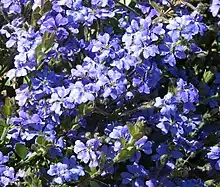Dampiera linearis
Dampiera linearis, commonly known as common dampiera[2] or wedge-leaved dampiera,[1] is an erect perennial herb in the family Goodeniaceae.[2] The species, which is endemic to the south-west of Western Australia, grows to between 15 and 60 cm (6 in–2 ft) high, with its blue to purple flowers appearing between July and December. It adapts readily to cultivation, particularly containers such as hanging baskets.
| Dampiera linearis | |
|---|---|
 | |
| Scientific classification | |
| Kingdom: | Plantae |
| Clade: | Tracheophytes |
| Clade: | Angiosperms |
| Clade: | Eudicots |
| Clade: | Asterids |
| Order: | Asterales |
| Family: | Goodeniaceae |
| Genus: | Dampiera |
| Species: | D. linearis |
| Binomial name | |
| Dampiera linearis | |
| Synonyms | |
|
Dampiera cuneata R.Br., 1810 | |
Taxonomy
The prolific botanist Robert Brown described Dampiera linearis in his 1810 work Prodromus Florae Novae Hollandiae et Insulae Van Diemen.[3] Its species name is the Latin adjective linearis "linear".[4] He described a D cuneata at the same time,[3] which has been synonymised with D. linearis.[1] Plants sold commercially were mislabeled as D. cuneata for many years.[4] Dutch botanist Willem Hendrik de Vriese described two further plants—D. azurea and D. eriophora—from the Swan River and Perth environs in the 1845 work Plantae Preissianae,[5] which are also now considered D. linearis.[1]
Description
An erect shrub, Dampiera linearis grows to between 15 and 60 cm (6 in–2 ft) in height,[2] with a suckering habit. New growth is hairy and becomes smooth with maturity.[4] The leaves are obovate to elliptical and can be entire or lobed,[2] measuring 1–4 cm long by 1–10 mm wide.[4] It produces flowers between July and December in its native range.[2] These are 1.5–2 cm wide, and light blue to purple with a yellow or white centre. The outer- or undersurface of the flowers is covered with fine hair. The flowers arise in groups of 1 to 3 from a peduncle that is also covered in hair.[4]
Distribution and habitat
Dampiera linearis is found across the southwest corner of Western Australia from Geraldton in the north to Esperance in the south east. It grows on sand- or clay-based soils over laterite, on ridges, or flat areas.[2]
Ecology
Plants of Dampiera linearis can survive bushfire and resprout and put on new growth quickly.[6]
Fieldwork on the Swan Coastal Plain indicated it was probably resistant to Phytophthora cinnamomi.[7]
Cultivation
Some forms of Dampiera linearis are cultivated and sold for their colourful flowers, while others have attractive grey foliage.[4] In cultivation, the species prefers a well-drained situation in full sun or light shade. It tolerates some dryness and moderate frost.[8] It does not tolerate waterlogged soils.[4] It makes an attractive plant for hanging baskets.[4]
Dampiera linearis is readily propagated by cuttings;[4] trials at Kings Park indicate that semi-hardened material is best and the average time to strike is 48 days.[9]
References
- "Dampiera linearis". Australian Plant Name Index (APNI), IBIS database. Centre for Plant Biodiversity Research, Australian Government, Canberra. Retrieved 27 February 2009.
- "Dampiera linearis". FloraBase. Western Australian Government Department of Biodiversity, Conservation and Attractions.
- Brown, Robert (1810). Prodromus Florae Novae Hollandiae et Insulae Van Diemen. London, UK: Richard Taylor and Company. p. 588.
- Elliot Rodger W.; Jones, David L.; Blake, Trevor (1984). Encyclopaedia of Australian Plants Suitable for Cultivation:Volume 3 - Ce-Er. Port Melbourne: Lothian Press. pp. 170–71. ISBN 0-85091-167-2.
- de Vriese, Willem Hendrik (1845). Plantae Preissianae. Vol. 1. pp. 400–01.
- Hobbs, R.J.; Atkins, L. (1990). "Fire-Related Dynamics of a Banksia Woodland in South-Western Western Australia". Australian Journal of Botany. 38 (1): 97–110. doi:10.1071/BT9900097.
- Shearer, B.L.; Dillon, M. (1996). "Susceptibility of Plant Species in Banksia Woodlands on the Swan Coastal Plain, Western Australia, to Infection by Phytophthora cinnamomi". Australian Journal of Botany. 44 (4): 433–45. doi:10.1071/BT9960433.
- Greig, D. (1987). The Australian Gardener's Wildflower Catalogue. Australia: Angus & Robertson. ISBN 0207154600.
- Webb, Mark (2013). Australian Native Plants: The Kings Park Experience. Collingwood, Victoria: Csiro Publishing. p. 55. ISBN 9780643106994.